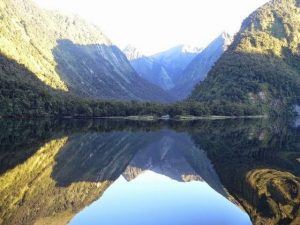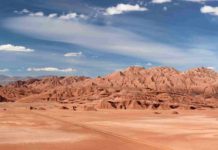
One of the big questions in biology is why certain plants and animals are found in some places and not others. Figuring out how species evolve and spread, and why some places are richer in species than others, is key to understanding and protecting the world around us. Mountains make a good laboratory for scientists tackling these questions: mountains are home to tons of biodiversity, in part due to all the different habitats at different elevations. In a new study in Science, researchers examined the plant life in the China’s Hengduan Mountains, the Himalaya Mountains, and the Qinghai-Tibet Plateau. Using DNA to build family trees of species, they learned that the diversity of plants in that region today can be traced back to newly-formed mountain ranges 30 million years ago, and monsoons that came later. It’s a concrete example of how climatic and environmental changes influence life on Earth.
“This paper addresses the fundamental question of why there are so many species in some parts of the world and not others,” says Rick Ree, a curator at Chicago’s Field Museum and corresponding author of the Science study. “The formation of this very species-rich community was fueled by ancient mountain-building and then subsequent effects of the monsoon. The biodiversity that we see today has been profoundly shaped by geology and climate.”
The paper focuses on plants growing above the treeline (called the alpine zone) in the Hengduan Mountains of southwestern China. “It’s an incredibly interesting part of the world, it’s a relatively small area that harbors one-third of all the plant species in China,” says Ree. “In the Hengduan Mountains, you can see coniferous forests, rushing glacial streams, craggy valleys, and meadows just teeming with wildflowers.” Some of the flowers, Ree notes, might be familiar to Western gardeners, including rhododendrons and delphiniums.
Ree and his colleagues wanted to find out how plants are distributed in the alpine regions of the Hengduan Mountains, Himalaya, and Qinghai-Tibet Plateau, and how they got there in the first place. To figure it out, they turned to phylogenetic reconstructions: essentially, using DNA and key pieces of fossil evidence to piece together the plants’ family trees, going back tens of millions of years.
The researchers compared the DNA of different plant species that live in the region, determining how closely related they were to each other and how they evolved. If you have DNA sequences for a bunch of different plants, by looking at the differences in their DNA and using fossil plants as benchmarks for how long it takes new species to arise, you can make an educated guess as to how long ago their common ancestor lived and figure out the family tree that makes the most sense.
In this study, Ree and his colleagues were able to trace the origins of alpine plants in the Hengduan, Himalaya, and Qinghai-Tibet Plateau. Many of the plants first evolved in the Hengduan Mountains. Then, as the Indian tectonic plate collided with Asia, slowly creating new mountains, a bunch of new habitats formed up the mountains’ sides and in the valleys below. And as the new mountains formed, the region began to experience more intense monsoons, possibly because the mountains altered the prevailing winds, creating new weather conditions.
“The combined effect of mountain-building and monsoons was like pouring jet fuel onto this flame of species origination,” says Ree. “The monsoon wasn’t simply giving more water for plants to grow, it had this huge role in creating a more rugged topography. It caused erosion, resulting in deeper valleys and more incised mountain ranges.”
“The theory is, if you increase the ruggedness of a landscape, you’re more likely to have populations restricted in their movement because it’s harder to cross a deeper valley than a shallow valley. So any time you start increasing the patchiness and barriers between populations, you expect evolution to accelerate,” says Ree.
And that’s exactly what the team found in reconstructing the plants’ genetic family tree: as the landscape grew more rugged over time, the now-isolated populations of plants veered off into their own separate species, resulting in the biodiversity we see today.
In addition to showing how geological and climate changes over the last 30 million years affect today’s spread of plants, Ree notes that the study has implications for better understanding the climate change the Earth is currently experiencing.
“This study sheds light on the conditions under which we get rich versus poor biodiversity,” says Ree. “Mountain ecosystems tend to be very sensitive to things like global warming, because the organisms that live there are dependent on a tight range of elevation and temperature. Understanding how historical environmental change affected alpine plants twenty million years ago can help us predict how today’s climate change will affect their descendants.”
Reference:
Wen-Na Ding, Richard H. Ree, Robert A. Spicer, Yao-Wu Xing. Ancient orogenic and monsoon-driven assembly of the world’s richest temperate alpine flora. Science, 2020; 369 (6503): 578 DOI: 10.1126/science.abb4484
Note: The above post is reprinted from materials provided by Field Museum.










